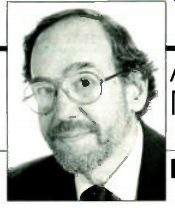Crosstalk: For different music, different speakers; equalizers and the well-trained ear.
Answers to Readers' Questions
By Larry Klein

Specialized Speakers
My local audio dealer told me that different types of speakers should be used for rock and classical music. Is there any truth in his position?
Martin Gaylord; Milwaukee, Wis.
It is true that a speaker that does a fine job of reproducing chamber music may not be suitable for rock, but only be cause it lacks the efficiency and acoustic-output capabilities (in the bass or overall) to attain the desired loudness levels. If rock or other electronics--based music causes distortion because your amplifier runs out of power attempting to drive your low-efficiency speakers, or because your speakers overload since they have inadequate power-handling capacity, then other speakers with greater efficiency or power-handling ability would, of course, do a better job.
However, the desirability of good performance in all the other traditional audio criteria-frequency range and smoothness, minimal distortion, and so forth--continue to be valid.
Most people who suggest different speakers for different music really haven't thought out the matter. If you want high-fidelity performance-meaning that the output of the speaker mimics, as faithfully as possible, the signal fed into it--then there can be so such things as rock or classical speakers, only good and bad ones. And a high-quality speaker should be able to reproduce signals accurately no matter what kind of music is involved. For example, if the recording has been engineered so that its bass has extra "sock" and its strings added "bite," the speakers should deliver those qualities-neither more nor less. And the only way a speaker can do that is when it doesn't have designed-in "sock" or "bite." In other words, a speaker that is able to deliver loud rock with true fidelity should do just as good a job when reproducing string quartets.
Power Needs
I recently installed one of Radio Shack's inexpensive audio power meters in my system and I'm perplexed by its reading. According to the meter, my amplifier is never called upon to deliver more than 20 watts per channel, even when played at very loud levels. Are my large bass-reflex speakers that efficient, or is the meter in error? Although I don't hear any distortion on peaks. I worry whether my 65-watt amplifier is adequate.
Daniel Pomeroy; Covington, Ky.
Using a very accurate power-indicating meter with medium-to low-efficiency speaker systems, I found that I aver aged perhaps 2 watts on background-level music, 20 watts on loud peaks, and 200 watts on momentary very loud peaks. Other speakers I have used required about 10 dB less power (translating to 0.2, 2, and 20 watts, respectively) to achieve the same loudness levels. Therefore, it is quite possible that a 65-watt amplifier is more than adequate for your large bass-reflex (vented) speaker systems, and that it never actually is called on to deliver its full output capacity.
When dealing with conventional cone speaker systems, it is helpful to keep in mind that there are design trade-offs involving enclosure size, efficiency, and low-bass response.
The larger the system, the more efficient it is likely to be.
Given equivalent-size systems, the more efficient units are likely to have less very low bass response than the less sensitive ones. In short, it is indeed difficult to achieve low bass from an efficient small box without some kind of electronic assistance.
Ear Training
I've been told that home equalizers are useful devices for "ear training." Can you give me more information?
Max Segal; San Diego, Calif.
Aside from their many corrective virtues--described in my November 1987 article "The Joys of Equalization" -- equalizers are wonderful training tools. Time spent with an equalizer may convince you that most of the elusive sonic properties, positive and negative, discussed endlessly among audiophiles are simply minor frequency-response variations that the ear translates into colorations and other sonic artifacts.
If you gently manipulate the equalizer's controls while listening for the effect on the music, you'll find bands that increase or decrease harshness, hollowness, airiness, muddiness, resolution, and so forth. For example, the transparency, "air," inner detail, and clarity provided by some moving-coil cartridges and a few amplifiers can be duplicated in other equipment by a slight boost of the two upper octave sliders of a ten-band equalizer.
Some readers will be disillusioned to learn that the special sonic qualities of some very expensive audio products result from nothing more than minor response anomalies; but that's life. Although equalizer-derived ear training may temporarily turn you into a cynic, ultimately it could make you into a more critical listener, one who is better able to appreciate genuine sonic advances when they do appear. Besides, your friends will be impressed when, on first hearing, you confidently proclaim that a new speaker's response is down by 3 dB at 80 Hz and that it has a 4-dB peak in the 3-to-8 kHz region.
We regret that the volume of mail is too great for us to answer all questions.
Also see:
Classical Reviews: Mozart and Beethoven E-flat Quintets; more Hummel concertos; rare Ravel cantatas; and delights from Delius. Dvorak, Villa-Lobos, and others.